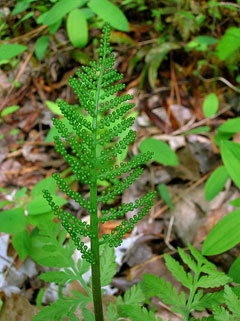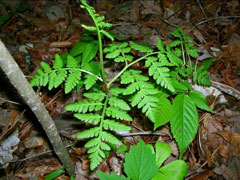 |
|
http://commons.wikimedia.org/wiki/User:TheAlphaWolf |
 |
| http://commons.wikimedia.org/wiki/User:TheAlphaWolf |
Translate this page:
Summary
Physical Characteristics

 Botrychium virginianum is an evergreen Fern growing to 0.4 m (1ft 4in). It is in leaf all year.
Botrychium virginianum is an evergreen Fern growing to 0.4 m (1ft 4in). It is in leaf all year.
Suitable for: light (sandy) and medium (loamy) soils and prefers well-drained soil. Suitable pH: mildly acid, neutral and basic (mildly alkaline) soils. It can grow in semi-shade (light woodland) or no shade. It prefers moist soil.
UK Hardiness Map
US Hardiness Map
Synonyms
Plant Habitats
Woodland Garden Sunny Edge; Dappled Shade; Shady Edge;
Edible Uses
Edible Parts: Root
Edible Uses:
This large succulent fern is boiled and eaten in the Himalayas[2]. The report does not say which part of the plant is used, though it is probably the root[K].
References More on Edible Uses
Medicinal Uses
Plants For A Future can not take any responsibility for any adverse effects from the use of plants. Always seek advice from a professional before using a plant medicinally.
Diaphoretic Emetic Expectorant Pectoral Poultice
A poultice or lotion made from the roots is applied to snakebites, bruises, cuts and sores[222, 257]. A tea made from the roots is emetic, induces sweating and is expectorant[222]. It is used in the treatment of lung ailments[222, 257].
References More on Medicinal Uses
The Bookshop: Edible Plant Books
Our Latest books on Perennial Plants For Food Forests and Permaculture Gardens in paperback or digital formats.

Edible Tropical Plants
Food Forest Plants for Hotter Conditions: 250+ Plants For Tropical Food Forests & Permaculture Gardens.
More

Edible Temperate Plants
Plants for Your Food Forest: 500 Plants for Temperate Food Forests & Permaculture Gardens.
More

More Books
PFAF have eight books available in paperback and digital formats. Browse the shop for more information.
Shop Now
Other Uses
References More on Other Uses
Cultivation details
Prefers a sandy loam with just a small portion of peat[1]. Requires sharp drainage[1]. Best grown in an open position[1]. Plants can be difficult to establish. The prothalli (young plants formed when the spores germinate) of this plant form a symbiotic relationship with a mycorrhizal fungus, similar to the association of orchid seedlings with an invading fungus[200]. Unlike most species of ferns, the fronds of this species grow up straight and not curled inward, crozier fashion[4]. Members of this genus are rarely if ever troubled by browsing deer[233].
References Carbon Farming Information and Carbon Sequestration Information
Temperature Converter
Type a value in the Celsius field to convert the value to Fahrenheit:
Fahrenheit:
The PFAF Bookshop
Plants For A Future have a number of books available in paperback and digital form. Book titles include Edible Plants, Edible Perennials, Edible Trees,Edible Shrubs, Woodland Gardening, and Temperate Food Forest Plants. Our new book is Food Forest Plants For Hotter Conditions (Tropical and Sub-Tropical).
Shop Now
Plant Propagation
Spores - best surface sown as soon as they are ripe in a greenhouse and do not allow the compost to dry out. Placing the pot in a plastic bag helps to maintain a humid atmosphere which promotes germination and growth. Prick out small clumps into pots when they are large enough to handle and keep moist until established. Grow on in a greenhouse for at least the first winter and plant out in late spring. Division. It is best not to try and disturb this plant[200].
Other Names
If available other names are mentioned here
Native Range
TEMPERATE ASIA: Russian Federation (Taymyr), Russian Federation (Koryak, Cukotskij avtonomnyj okrug), Japan NORTHERN AMERICA: Canada (Northwest Territories, Yukon, New Brunswick, Newfoundland and Labrador, Nova Scotia, Ontario, Prince Edward Island, Québec, Alberta, British Columbia, Manitoba, Saskatchewan), Mexico (Chihuahua, Durango, Nuevo León, San Luis Potosí, Sonora, Tamaulipas, Chiapas, Ciudad de México, Colima, Guanajuato, Guerrero, Hidalgo, Jalisco, México, Michoacán de Ocampo, Morelos, Nayarit, Oaxaca, Puebla, Querétaro, Tlaxcala, Veracruz de Ignacio de la Llave), United States (all States except California) SOUTHERN AMERICA: Costa Rica, Guatemala, Honduras, Nicaragua, Panama, Venezuela, Colombia, Ecuador, Peru EUROPE: Finland, Sweden, Austria, Switzerland, Hungary, Poland, Estonia, Lithuania, Latvia, Russian Federation (Karelia, Neneckij avtonomnyj okrug), Ukraine, Italy, Romania, Slovenia
Weed Potential
Right plant wrong place. We are currently updating this section.
Please note that a plant may be invasive in one area but may not in your area so it's worth checking.
Conservation Status
IUCN Red List of Threatened Plants Status :

Growth: S = slow M = medium F = fast. Soil: L = light (sandy) M = medium H = heavy (clay). pH: A = acid N = neutral B = basic (alkaline). Shade: F = full shade S = semi-shade N = no shade. Moisture: D = dry M = Moist We = wet Wa = water.
Now available:
Food Forest Plants for Mediterranean Conditions
350+ Perennial Plants For Mediterranean and Drier Food Forests and Permaculture Gardens.
[Paperback and eBook]
This is the third in Plants For A Future's series of plant guides for food forests tailored to
specific climate zones. Following volumes on temperate and tropical ecosystems, this book focuses
on species suited to Mediterranean conditions—regions with hot, dry summers and cool, wet winters,
often facing the added challenge of climate change.
Read More
Expert comment
Author
(L.)Sw.
Botanical References
200270
Links / References
For a list of references used on this page please go here
Readers comment
| Add a comment |
|
If you have important information about this plant that may help other users please add a comment or link below. Only comments or links that are felt to be directly relevant to a plant will be included. If you think a comment/link or information contained on this page is inaccurate or misleading we would welcome your feedback at [email protected]. If you have questions about a plant please use the Forum on this website as we do not have the resources to answer questions ourselves.
* Please note: the comments by website users are not necessarily those held by PFAF and may give misleading or inaccurate information.
To leave a comment please Register or login here All comments need to be approved so will not appear immediately.
|
Subject : Botrychium virginianum
|
|
|
|